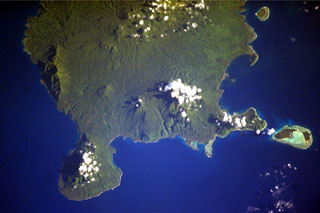Report on Suretamatai (Vanuatu) — July 1991
Bulletin of the Global Volcanism Network, vol. 16, no. 7 (July 1991)
Managing Editor: Lindsay McClelland.
Suretamatai (Vanuatu) Fumarolic activity
Please cite this report as:
Global Volcanism Program, 1991. Report on Suretamatai (Vanuatu) (McClelland, L., ed.). Bulletin of the Global Volcanism Network, 16:7. Smithsonian Institution. https://doi.org/10.5479/si.GVP.BGVN199107-257010
Suretamatai
Vanuatu
13.8°S, 167.47°E; summit elev. 921 m
All times are local (unless otherwise noted)
"During our survey, no change in activity at the major geothermal areas (Frenchman's Solfataras and Hell's Gate) was noted, with respect to descriptions by Aubert de la Rue (1937) and Hochstein (1980). Slightly superheated fumaroles (with sulfur deposits), hot springs, and boiling ponds up to 3 m in diameter occurred over a 300-m strip along the Sulfur River (E flank) between 300 to 400 m elevation. The temperature of the Sulfur River at Hell's Gate remained stable at 50°C.
"Soretimeat . . . is a composite volcano built on an ancient Pleistocene edifice. Ash emissions reported in 1860 and 1965-66 are most likely to have been from hydrothermal explosions (Ash and others, 1980)." ["Flames" were observed during an apparent eruption in 1865 (Atkin, 1868).]
References. Ash, R.P., Carney, J.N., and MacFarlane, A., 1980, Geology of the northern Banks Islands: New Hebrides Geological Survey Regional Report, p. 1-47.
Atkin, J., 1868, On volcanoes in the New Hebrides and Banks Islands: Proceedings of the Geological Society of London, v. 24, p. 305-307.
Aubert de la Rue, E., 1937, La Volcanisme aux Nouvelles Hebrides (Melanesie): BV, v. 2, p. 79-142.
Hochstein, M.P., 1980, Geology of the Northern Banks Islands: New Hebrides Geological Survey Regional Report, p. 47-49.
Geological Summary. Suretamatai volcano (also known as Soritimeat) forms much of Vanua Lava Island, one of the largest of Vanuatu's Banks Islands. The younger lavas overlie a number of small older stratovolcanoes that form the island. In contrast to other large volcanoes of Vanuatu, the dominantly basaltic-to-andesitic Suretamatai does not contain a youthful summit caldera. A chain of small stratovolcanoes oriented along a NNE-SSW line gives the low-angle volcano an irregular profile. The youngest cone, near the northern end of the chain, is the largest and contains a lake of variable depth within its 900-m-wide, 100-m-deep summit crater. Activity reported during the 19th century consisted of moderate explosive eruptions.
Information Contacts: C. Robin and M. Monzier, ORSTOM, Nouméa, New Caledonia; M. Lardy and C. Douglas, ORSTOM, Vanuatu; C. Mortimer, Dept. of Geology, Mines, and Rural Water Supply, Vanuatu; J. Eissen, ORSTOM, France.

